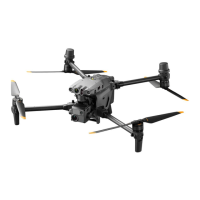4. Press and then press and hold the power button to power on/off the aircraft. The power indicator glows
solid after the aircraft is powered on.
Push the battery release toggles outward to remove TB30 batteries.
Make sure to push and hold the frame arm folding button and fold the arms in before
transporting the aircraft separately.
When transporting the unpacked dock, make sure to remove the aircraft from the dock for
separate transportation.
Linking to the Dock
The aircraft and the dock require activation before use for the first time. An internet
connection is required for the remote controller during activation.
When the dock is connecting to the remote controller and the dock cover is opening
using DJI Pilot 2, make sure to keep a safe distance from the dock cover movement
mechanism to avoid injury. Press any of the emergency stop buttons on the dock to stop
the dock covers from opening, if necessary.
When the dock cover needs to be closed after the aircraft is placed in the dock, it is
recommended to close the cover in the app or on FlightHub 2. Before closing the dock
covers (including manual closing), make sure to move the two blades for each motor to
be at 90° with each other in order to avoid breaking the propellers when closing the
dock cover.
1. Open the dock electrical cabinet door. Use the USB-C cable included in the Dock Bundle to connect the USB-C
port of the remote controller to the USB-A port of the dock electrical cabinet.
2. Power on the remote controller, run DJI Pilot 2, and follow the prompts to complete the activation for the
aircraft.
3. Make sure the driving rods on the landing pad are pulled back, the aircraft heading is consistent with the
arrow mark on the landing pad, and the aircraft is placed on the landing pad. Move the two blades for
each motor to be at 90° with each other to complete the configuration, as shown in the diagram. Make sure
to close the dock cover in the app.
4. Dock Onsite Debugging in DJI Pilot 2 provides the aircraft status and operations such as charging aircraft.

